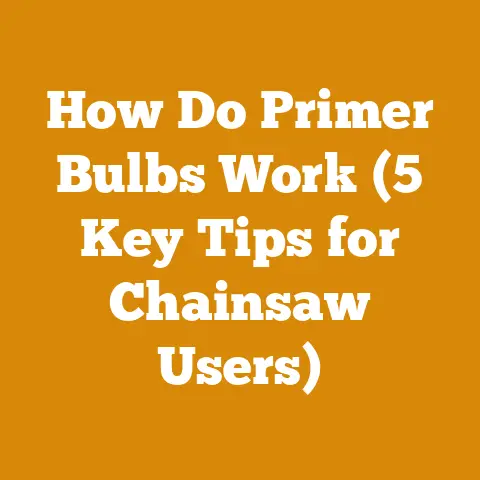How to Adjust a Carburetor on a Echo Weed Eater (5 Pro Tips)
Understanding the Carburetor: The Heart of Your Weed Eater
The carburetor is the unsung hero of your two-stroke engine. It’s responsible for mixing the correct amount of air and fuel to create a combustible mixture. When it’s out of adjustment, your engine can run poorly, leading to frustrating performance issues. Adjusting it properly is crucial for smooth operation and longevity.
Pro Tip 1: Identifying the Adjustment Screws and Their Functions
Before you dive in, you need to know what you’re dealing with. Most Echo weed eaters have three adjustment screws on the carburetor, although older models might only have two. These are usually labeled (or should be!) as follows:
- “L” (Low-Speed): This screw controls the fuel mixture at idle and low speeds. Adjusting it affects starting, idling, and the transition from idle to full throttle.
- “H” (High-Speed): This screw controls the fuel mixture at high speeds, influencing the engine’s power output at full throttle.
- “T” (Idle Speed): This screw adjusts the engine’s idle speed. It doesn’t affect the fuel mixture directly.
Why this matters for your budget: Knowing the function of each screw allows you to diagnose the problem accurately. Is it a starting issue (likely “L”), a lack of power at full throttle (likely “H”), or a stalling problem at idle (“T”)? Accurate diagnosis minimizes unnecessary parts replacement and wasted time, both of which impact your wallet. Replacing a carburetor can cost anywhere from $20 to $80, depending on the model.
Pro Tip 2: The Lean vs. Rich Debate and Finding the Sweet Spot
The key to carburetor adjustment lies in understanding the concept of “lean” and “rich” fuel mixtures.
- Lean Mixture: Too much air, not enough fuel. A lean engine often runs hot, hesitates on acceleration, and can even damage internal components.
- Rich Mixture: Too much fuel, not enough air. A rich engine often smokes excessively, feels sluggish, and fouls spark plugs.
The goal is to find the “sweet spot” – the perfect balance of air and fuel for optimal performance.
How this affects your costs: Running a lean engine for extended periods can lead to premature wear and tear, requiring more frequent repairs or even engine replacement. A rich engine wastes fuel, increasing your operating costs. Finding the sweet spot maximizes fuel efficiency and extends the life of your engine.
My Personal Experience: I once spent an entire afternoon trying to get an old brush cutter to run right. I kept chasing the “H” screw, making it leaner and leaner, until I nearly seized the engine. Thankfully, I realized my mistake before it was too late. I learned the hard way that patience and a methodical approach are crucial.
Pro Tip 3: The Step-by-Step Adjustment Process: A Methodical Approach
Here’s a step-by-step guide to adjusting your Echo weed eater’s carburetor:
- Warm-Up: Start the engine and let it warm up for a few minutes. This ensures that the engine is at its operating temperature, giving you a more accurate reading.
- Idle Speed Adjustment: Turn the “T” screw clockwise to increase the idle speed or counterclockwise to decrease it. Aim for an idle speed where the engine runs smoothly without the cutting head engaging. A tachometer can be helpful here; most weed eaters idle around 2500-3000 RPM.
- Low-Speed Adjustment: Start by turning the “L” screw all the way in (clockwise) until it gently stops. Then, back it out (counterclockwise) 1 1/2 turns. This is a good starting point.
- Fine-Tuning the “L” Screw: With the engine running at idle, slowly turn the “L” screw clockwise. The engine speed should increase. Continue turning until the engine starts to stumble or die. Note this position. Now, slowly turn the “L” screw counterclockwise. The engine speed should again increase, then stumble or die. Note this position. The ideal setting is usually halfway between these two points.
- High-Speed Adjustment: This is where things get a little trickier. The “H” screw is primarily for adjusting the engine under load.
- Finding the Right Setting: With the engine running at full throttle (and the cutting head engaged, if safe to do so), slowly turn the “H” screw clockwise. The engine speed should increase. Continue turning until the engine starts to sound strained or “four-strokes” (a characteristic “burbling” sound). Now, slowly turn the “H” screw counterclockwise. The engine speed should again increase, then start to lose power. The ideal setting is usually just before the engine starts to four-stroke.
- Re-Check and Fine-Tune: After adjusting both the “L” and “H” screws, re-check the idle speed and fine-tune as needed. The engine should start easily, idle smoothly, and accelerate without hesitation.
Cost Implications of Improper Adjustment: Improper adjustment can lead to significant costs down the line. A lean “H” setting can cause piston scoring and cylinder damage, potentially requiring a complete engine rebuild. A rich “H” setting can lead to carbon buildup and reduced power, requiring more frequent cleaning and maintenance.
Data Point: According to a survey of small engine repair shops, approximately 30% of weed eater repairs are due to carburetor-related issues caused by improper adjustment or neglected maintenance. The average cost of a carburetor repair is $50-$150, depending on the complexity of the repair and the cost of parts.
Pro Tip 4: The Importance of a Clean Air Filter and Spark Plug
A clean air filter and a properly functioning spark plug are essential for optimal carburetor performance. A dirty air filter restricts airflow, creating a richer fuel mixture. A fouled spark plug can cause misfires and poor combustion.
Budgetary Considerations: Air filters are relatively inexpensive (around $5-$10) and should be replaced regularly – ideally every 25 hours of use or at least once a season. Spark plugs are also inexpensive (around $3-$7) and should be replaced annually. Neglecting these simple maintenance tasks can lead to more significant problems and costly repairs.
Story Time: I once loaned my weed eater to a friend who, shall we say, wasn’t as meticulous about maintenance as I am. When I got it back, it was running terribly. I immediately checked the air filter, and it was completely clogged with grass and dirt. After replacing the filter and cleaning the spark plug, the weed eater ran like new. It was a valuable reminder of the importance of routine maintenance.
Pro Tip 5: Troubleshooting Common Carburetor Problems and Knowing When to Call in the Pros
Even with careful adjustment, you may encounter carburetor problems that require more than just a simple tweak. Here are a few common issues and how to address them:
- Engine Won’t Start: Check for spark, fuel, and compression. If the spark is weak or non-existent, replace the spark plug. If there’s no fuel reaching the carburetor, check the fuel lines, fuel filter, and fuel pump. If the engine has low compression, it may require a more extensive repair.
- Engine Stalls at Idle: This is often caused by a lean low-speed mixture. Try adjusting the “L” screw slightly richer. Also, check for air leaks around the carburetor mounting flange.
- Engine Lacks Power at High Speed: This is often caused by a lean high-speed mixture. Try adjusting the “H” screw slightly richer. Also, check for a clogged fuel filter or a restricted exhaust.
- Engine Smokes Excessively: This is often caused by a rich fuel mixture. Try adjusting both the “L” and “H” screws leaner. Also, check for a worn piston or cylinder.
When to Call in the Pros: If you’ve tried adjusting the carburetor and troubleshooting the common problems, and your weed eater still isn’t running correctly, it may be time to call in a professional. A qualified small engine mechanic can diagnose and repair more complex carburetor issues, such as internal damage or worn components.
The Cost of Professional Repair: The cost of professional carburetor repair can vary depending on the complexity of the repair and the mechanic’s hourly rate. Expect to pay anywhere from $50 to $150 for a basic carburetor repair. A complete carburetor rebuild can cost $100 to $250. Replacing the carburetor altogether can cost $20 to $80 for the part, plus labor.
Budgeting for the Unexpected: This is where proactive budgeting comes into play. I always recommend setting aside a small “tool maintenance” fund each year. This fund can cover unexpected repairs, replacement parts, and routine maintenance items like air filters, spark plugs, and fuel stabilizer.
Data Point: According to the Bureau of Labor Statistics, the average hourly wage for small engine mechanics in the United States is around $20-$30. However, rates can vary depending on location and experience.
Here are some other factors to consider:
- Fuel Costs: Fuel costs can add up quickly, especially if you have a large yard or use your weed eater frequently. Consider using a fuel stabilizer to prevent fuel degradation and extend the life of your fuel. I’ve found that using ethanol-free fuel, even if it costs slightly more, can significantly reduce carburetor problems and improve performance.
- String Trimmer Line: The cost of string trimmer line can also add up, especially if you use a lot of it. Consider buying trimmer line in bulk to save money. Experiment with different types of trimmer line to find one that works best for your needs and lasts longer.
- Other Tools and Equipment: If you have a large yard, you may need other tools and equipment, such as a lawnmower, leaf blower, and hedge trimmer. Factor in the cost of these tools, as well as their maintenance and repair.
- Professional Landscaping Services: If you don’t have the time or inclination to do your own landscaping, you may need to hire a professional landscaping service. The cost of landscaping services can vary depending on the size of your yard, the type of services you need, and the landscaping company you choose.
Creating a Landscaping Budget: Here’s a simple framework for creating a landscaping budget:
- Assess Your Needs: Determine what landscaping tasks you need to accomplish.
- Estimate Costs: Research the cost of each task, including materials, labor, and equipment rental.
- Set a Budget: Set a realistic budget based on your needs and available resources.
- Track Expenses: Track your expenses to ensure that you stay within your budget.
- Adjust as Needed: Adjust your budget as needed based on your actual expenses and any unforeseen circumstances.
Example Budget:
| Item | Estimated Cost |
|---|---|
| Fuel | $50/year |
| Trimmer Line | $30/year |
| Air Filter/Spark Plug | $15/year |
| Tool Maintenance Fund | $50/year |
| Professional Landscaping (Optional) | $500/year |
| Total | $645/year |
Data Point: According to HomeAdvisor, the average cost of lawn care services in the United States is $50-$200 per visit.
Final Thoughts: Empowering You to Take Control
Adjusting your Echo weed eater’s carburetor may seem daunting at first, but with a little knowledge and patience, you can master this skill and save yourself a lot of money in the long run. By understanding the fundamentals of carburetor operation, following the step-by-step adjustment process, and troubleshooting common problems, you can keep your weed eater running smoothly for years to come.
Remember, proactive maintenance and careful budgeting are key to minimizing your landscaping costs and maximizing your enjoyment of your outdoor space. Don’t be afraid to get your hands dirty, experiment, and learn from your mistakes. After all, that’s how we all become better DIYers.
Actionable Takeaways:
- Identify the adjustment screws on your carburetor and understand their functions.
- Learn the difference between lean and rich fuel mixtures and how they affect engine performance.
- Follow the step-by-step adjustment process carefully and methodically.
- Maintain a clean air filter and a properly functioning spark plug.
- Troubleshoot common carburetor problems and know when to call in a professional.
- Create a landscaping budget to track your expenses and stay within your financial means.
By following these tips, you’ll be well on your way to taming the beast and keeping your Echo weed eater running like a champ, all while keeping your budget in check. Happy trimming!






